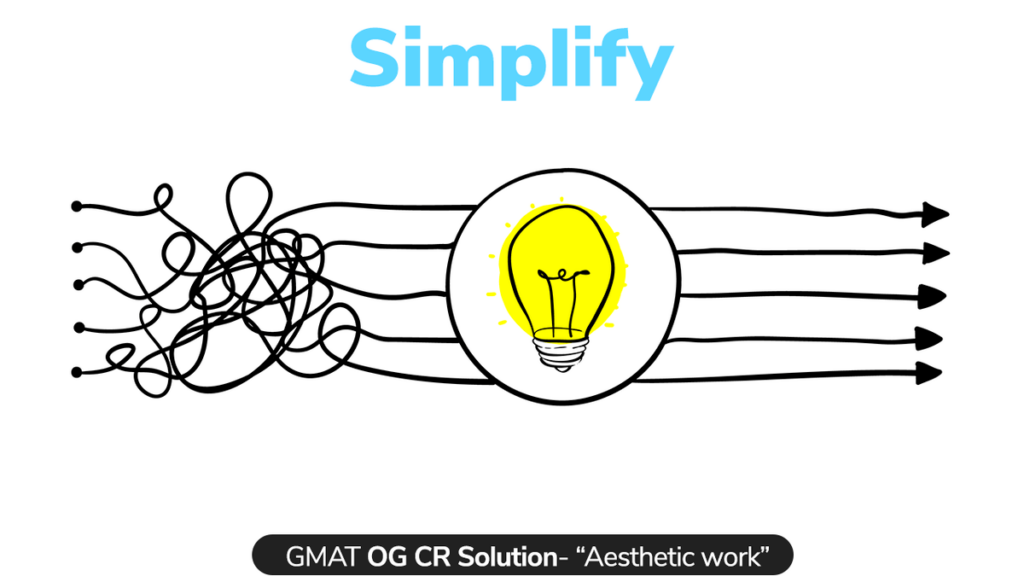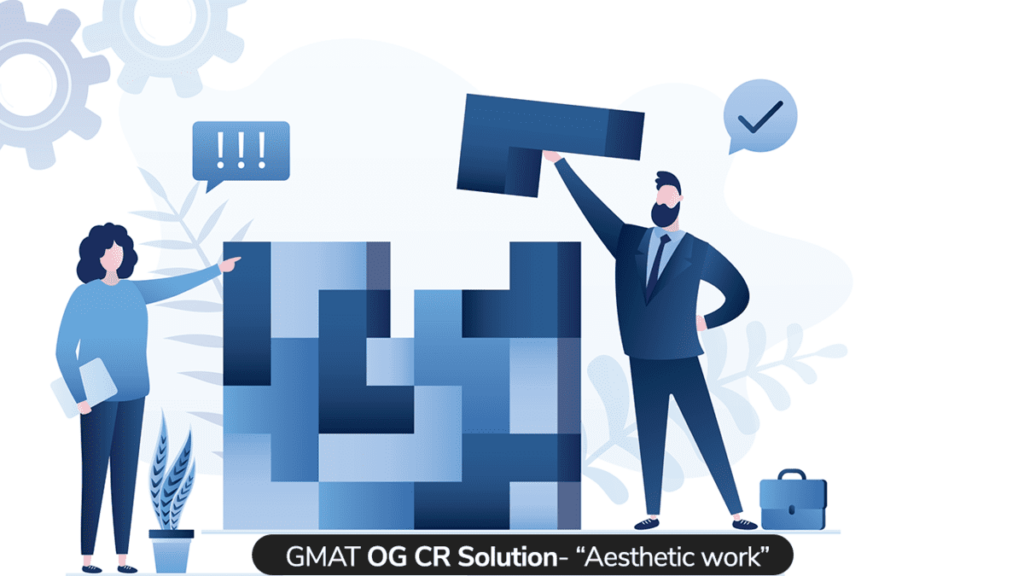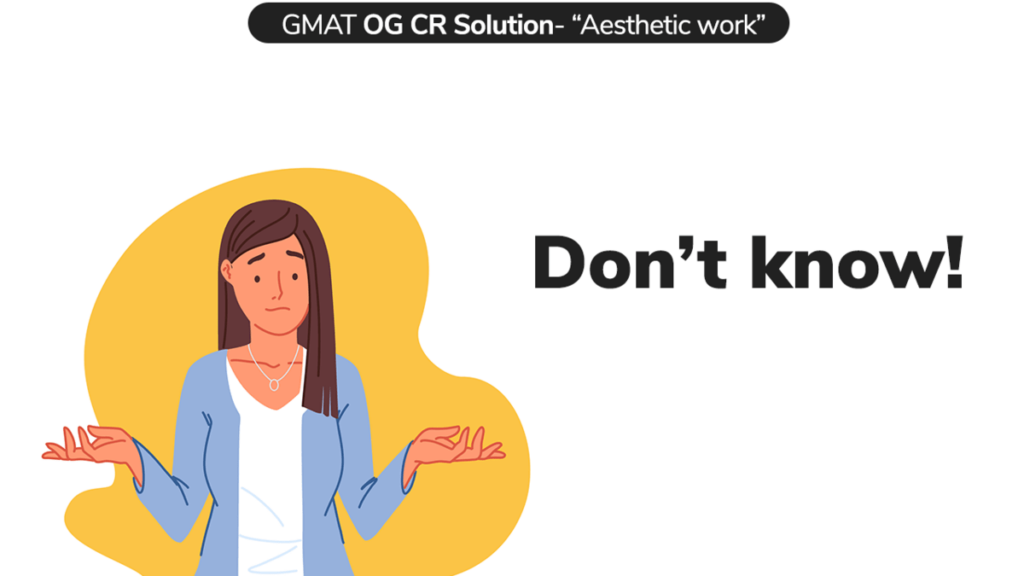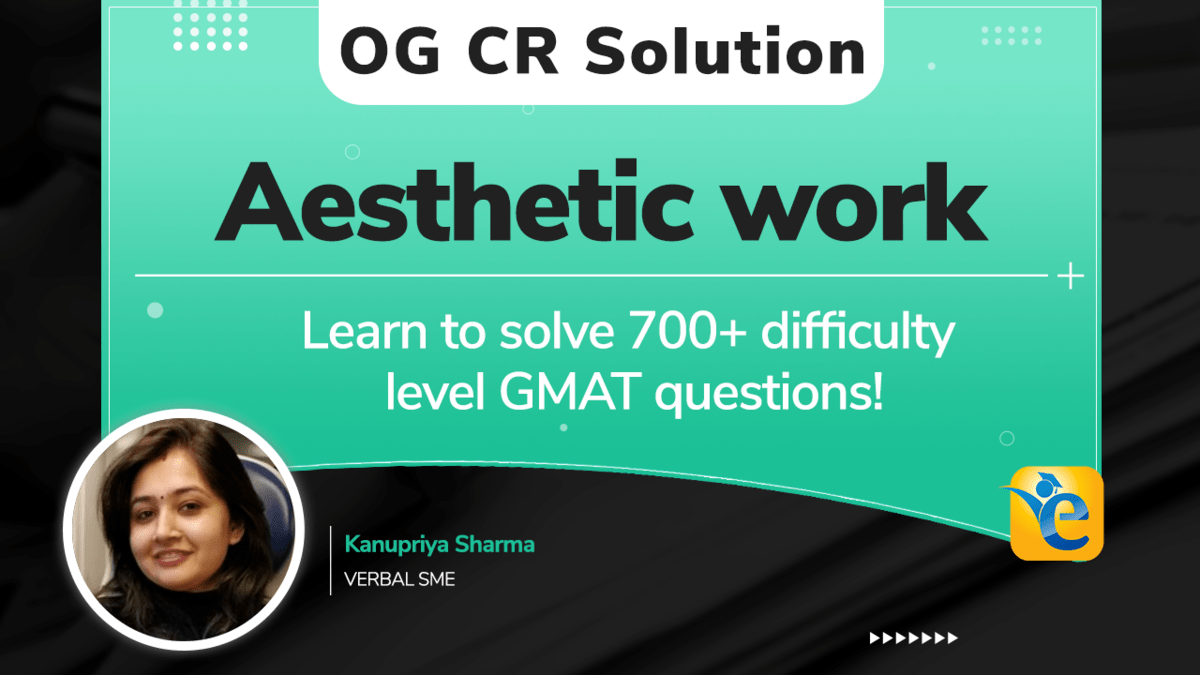In this article, we’ll look at the solution to this Official Guide (OG) question CR70870.01 – “Some theorists and critics insist that…” on Critical Reasoning:
Some theorists and critics insist that no aesthetic evaluation of a work of art is sound if it is based even in part on data about the cultural background of the artist. This opinion is clearly false. The only sound aesthetic evaluations of artists’ works are those that take into account factors such as the era and the place of the artists’ births, their upbringing and education, and the values of their societies—in sum, those factors that are part of their cultural background.
The above argument is most vulnerable to which of the following objections?
[Refer to GMAT Official Guide for options]
Here is some general information about this OG question:
- PQID: CR70870.01
- Difficulty Level: Hard
- Most Common Incorrect option choice: Choice C and Choice D
- Question Type: Flaw
OG Video Solution – CR70870.01 – Some theorists and critics insist that…| “Aesthetic Evaluation”
OG Solution – CR70870.01 – Some theorists and critics insist that…| “Aesthetic Evaluation”
Hi Student, is your head still spinning after trying this question? Mine is.
This is one of those rare OG questions in which students with a good vocabulary definitely have an advantage. So, if you are not one of them, let me start by saying – Relax! Even though enhancing your vocabulary is always a good thing to do, you don’t need to cram an entire dictionary of definitions into your head in order to score well on the GMAT.
This question does not test just your vocabulary but also tests your ability to understand answer choices. You can actually ask three of your friends to sit with a dictionary and solve the question. I am sure that you will get a variety of interpretations of the very same answer choices. So, any advantage that one may have because of the good vocabulary gets nullified if the student is not able to comprehend what the passage and answer choices intend to convey. Hence, try to learn something from this question instead of getting scared of it and trust your CR skills. What I can assure you of is that you will get valuable takeaways from it.
So, let’s get started.
Complex Words Simplified
Let’s start by understanding the meaning of the not so common words that have been used in the passage:
- Presuppose – to accept that something is true before it has been proved, i.e., to assume
- Purport- Pretend to do something
- Equivocal- Confusing
Fun fact- “equi” means equal, and “voc” means voice in Latin. So, things that are equivocal are confusing because equal voice has been given, and thus they are ambiguous.
- Evaluative disputes – Dispute related to an evaluation
You may be aware of some or all or none of these words. Accordingly, you would have found it difficult to understand this question. However, now that you know the meaning of these terms try solving this question again.
Also, take note of these words. Next time you see them, you will know what these words mean.
Let’s now understand what the flaw in this argument is.
The Flaw In Simple Words
In this passage, the author presents a claim of a 3rd party, then conveys his opinion that the claim is false. Then he tries to support his opinion with another claim, which is exactly the opposite of the claim made by the third party.
So, did you notice something?
In every CR passage, the conclusion is derived from some information, i.e., authors present some reason to arrive at their conclusion.
However, is that the case here? Has the author provided any reason to arrive at his conclusion in this passage?
No. Instead of providing reason/ evidence to support his opinion, he has provided another claim which is just the opposite of what the theorists and critics believe.
PS: A claim can be used to arrive at the conclusion. The issue here is that the conclusion and the supporting claim are more or less the same and are just contradicting what the theorists and critics believe, without providing any actual point to justify this stand.
Consider these two arguments, for example:
- Some researchers claim that mass vaccination for coronavirus will make the virus stronger. However, this opinion is false. Mass vaccination is the only way of making the virus weak.
- Some researchers claim that mass vaccination for coronavirus will make the virus stronger. However, this opinion is false. Mass vaccination has been found to be very effective against other viruses, and hence it seems to be the only way of making the virus weak.
Notice the difference between these two arguments. The first one states one claim and then provides two contradicting claims. The second one, on the other hand, states a claim, provides a counterclaim, and then provides the reason behind the same.
Hence, the author has provided a conclusion without providing any supporting reason/ evidence behind the same. Instead, he has used another claim to support his conclusion, but the claim is just the opposite of the claim made by theorists and critics.
And there we are! We have so easily identified the flaw in the passage. The correct answer choice should also convey the same.
Why Can the Last Statement Not Be Considered Evidence?
If you are confused about the role of the last statement, then you are probably thinking that the author may be providing actual data in the last statement, and it may not just be his claim.
If that is the case, read the last sentence again. Let me simplify it:
- The only sound evaluations are those that take into account the cultural background.
Is the author reporting some data here? No.
In order to report some data, the author would have written something like
- “The only sound evaluations are those that have taken into account the cultural background.”
It is so because if the author is presenting data about sound evaluations that have been carried out in the past, then these evaluations would not be considering the given facts in the present as is being conveyed by the last statement (Yes! You are right. You need to keep your SC hats on). Hence, the last statement is a claim and not evidence.
Let’s now simplify the complex answer choices.

Correct Choice A
In simple words, choice A conveys that the author assumes the conclusion and pretends to provide evidence for the same.
So, can we say that
- The author assumes the conclusion? – Yes, the main conclusion, i.e., the claim that the opinion of theorists and critics is false, has been assumed to be correct by the author without sufficient data to prove it correct. Hence, we can say that the argument presupposes the conclusion.
- The author pretends to provide evidence for the main conclusion?– Yes, the author is trying to support his conclusion with a claim instead of evidence. So, we can say that the author is pretending to provide evidence for the main conclusion.
Hence, we did not find any blatant error in choice A. Hence, it can be the correct answer.
What If I Don’t Know the Meaning of “Presuppose” and “Purports”
I would suggest that you analyze the remaining answer choices. If you can reject them on solid grounds, choice A will be your correct answer.
Most Popular Incorrect Choice- Choice C
Simplified choice C– The argument derives the main conclusion by presenting a confusing interpretation of some important terms.
Now that the choice has been simplified, do you think the argument presents any confusing interpretation of any term? Clearly No.
Most likely, if you selected choice C, you were not sure of the meaning conveyed by choice C as well as the meaning conveyed by choice A. In that case, I would admit that the question tested your vocab – but don’t worry. Such questions are rare.
If that was not the case, then your understanding of the passage was not correct. You definitely need to be more careful while analyzing the passage.
Another Popular Incorrect Answer Choice- Choice D
Well, even though choice D does not use any difficult words, it is difficult to understand.
How do we analyze such complex answer choices- by breaking them down? As we discuss in our Master Comprehension course, any long or complex sentence can be understood by reading it in chunks and then assimilating the meaning.
Let’s do that for choice D.

- The argument assumes that
Ok, so as per choice D, the argument assumes something. Let’s see what.
- the production of an effect is evidence of
Here, choice D talks about the production of an effect. Since choice D is about the passage, we need to understand that what the effect can refer to. IMO, the only effect possible as per the passage is sound aesthetic evaluation.
So, production of an effect would mean- Activity for making the aesthetic evaluation (henceforth called evaluation) sound.
Hence, this portion conveys that whatever is done to make the evaluation sound is evidence of something.
- an intention to produce that effect.
This portion means- an intention to make the evaluation sound.
If we now combine the three pieces, choice D conveys that –
The passage assumes that whatever is done to make the evaluation sound is evidence of an intention to make the evaluation sound.
Even the simplified version is not so simple!
However, is it anyhow related to the flaw that we found out? Not at all. The passage does not talk about any intention at all.
Hence, choice D is incorrect.
Let’s also quickly check choice B and choice E.
Choice B
Choice B can be rejected for two reasons.
- Firstly, the argument does not cite any evidence.
- Secondly, even if you mistook the last claim to be evidence, it does not undermine the main conclusion.
- Hence, choice B is incorrect.
Choice E
As per choice E, the argument assumes that an evaluative dispute, such as the one regarding aesthetic evaluation, can be solved by providing facts as evidence.
However, the argument neither provides any factual evidence nor talks about resolving any evaluative disputes.
Hence, choice E is incorrect.
What If I Don’t Know the Meaning Of Any Of The Difficult Words?

Well, in that case, I would suggest not spending too much time on such a question on your test. Such questions are rare; hence, as soon as you realize that you will not be able to infer the meaning of any of these words, you should save your time and use it to solve other questions.
However, if you get such a question in your preparation stage, take a note of what you learn from it and make sure to apply the same wherever required.
Takeaways – Some theorists and critics insist that…
- Try to infer the meaning of difficult words from the context.
- If you are not sure of meaning conveyed by one choice, see if you can reject other answer choices on solid grounds.
- Understand complex sentences by reading them in smaller chunks and then assimilating the meaning, as we did in choice D.
- If you find too many difficult words that cannot be inferred from the context, save your time and move to the next question.
Practice OG questions
You can try these questions to check if you can simplify complex answer choices as discussed:
OG Question 1 – In a certain rural area, people normally dispose…
In a certain rural area, people normally dispose of household garbage by burning it. Burning household garbage releases toxic chemicals known as dioxins. New conservation regulations will require a major reduction in packaging—specifically, paper and cardboard packaging—for products sold in the area. Since such packaging materials contain dioxins, one result of the implementation of the new regulations will surely be a reduction in dioxin pollution in the area.
Which of the following, if true, most seriously weakens the argument?
OG Question 2 – Sasha: It must be healthy to follow a diet…
Sasha: It must be healthy to follow a diet high in animal proteins and fats. Human beings undoubtedly evolved to thrive on such a diet, since our prehistoric ancestors ate large amounts of meat.
Jamal: But our ancestors also exerted themselves intensely in order to obtain this food, whereas most human beings today are much less physically active.
Jamal responds to Sasha by doing which of the following?
OG Question 3 – City resident: These new digital electronic billboards should…
Try this question to cement your understanding of the structure of an argument.
City resident: These new digital electronic billboards should be banned for light pollution since they are much too bright.
Outdoor advertising spokesperson: No, that’s not true. Testing with a sophisticated light meter shows that at night they throw off less light than traditional billboards that are reflectively lit. Your mistaken perception that they are brighter comes from looking directly at the light source—the screen itself.
The underlying strategy of the spokesperson’s response to the resident is most analogous to the underlying strategy of which of the following?
Happy learning!
Kanupriya
Planning to take the GMAT? We can give you access to quality online content to prepare. We are the most reviewed GMAT prep company on the GMAT club with more than 2200+ reviews and have delivered 10x 700+ scores than the average GMATClub partner. Why don’t you take a free trial and judge it for yourself? Write to us at acethegmat@e-gmat.com in case of any queries.















